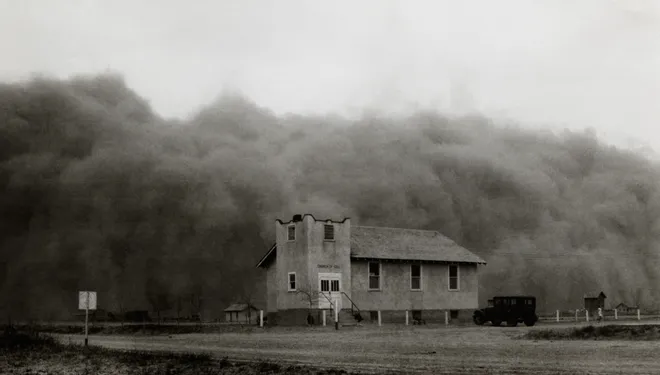Dust Bowl: Worst Drought in Midwest History
- Eli Mirek

- Sep 17
- 3 min read
Hey y'all! While researching for my blog "Crop Circles: They Saved the Midwest," I learned a bit about the Dust Bowl of the 1930s. Today, I am going to expand a bit more on this dry, depressing period of U.S. history. Specifically, I will look at what caused the Dust Bowl, the effects on agriculture and communities in the region, and include some interesting photos!
The Dust Bowl was a region of the U.S. that was hit with a horrible drought period during the 1930s. Extreme winds and dust storms swept across the region, crops were unable to grow, and death spread within communities. It heavily impacted the agriculture, ecology, and economics of not only the region, but the entire country. Because the Great Depression was already underway, communities in the Dust Bowl region were impacted even more, and many families migrated to find better living conditions and job opportunities. The main states effected were Colorado, Kansas, Texas, Nebraska, New Mexico, and Oklahoma, but topsoil from the dust storms reached all the way to Washington D.C. and New York.
According to the Dust Bowl webpage on History.com, "the Dust Bowl was caused by several economic and agricultural factors, including federal land policies, changes in regional weather, farm economics, and other cultural factors." The Homestead Act of 1862, the Kinkaid Act of 1904, and the Enlarged Homestead Act of 1909 led to many Americans moving into the Midwest and southern Great Plains region in promise of owning land.
The new landowners, as inexperienced farmers, plowed up native grasses in order to plant crops, specifically wheat. While you may be thinking plowing up native grasses isn't that bad and wouldn't affect the ecology of the region, you would be wrong. Native grasses have roots that go deep into the soil, which holds moisture even in times of drought. Because moisture is retained and native grasses are tall, the soil is not kicked up by wind easily. When drought began in 1930 and crops started to fail, the soil was exposed and blew away, causing the dust storms that devastated the region.
The dust storms were truly evil. Clouds of dust would cover the sky for days at a time and would make its way into homes, soiling (quite literally) stored food. Livestock died from suffocation and thousands of Americans died from dust-induced pneumonia. The worst dust storm, often referred to as Black Sunday, happened on April 14, 1935. It is estimated that 3 million tons of dust, sand, and topsoil was blown off during the infamous storm.
Because of the terrible physical and economical effects on people living in the region, many individuals, especially from Oklahoma, migrated west. About 18.4 percent of Oklahoma's population migrated during the 30s, most of them moving to California. While the drought ended in 1939, the economic and agricultural effects lasted up to the 1950s. Farmland quality was low, and many towns had been deserted.
Many photos were taken of dust storms and the people they affected. I find them quite interesting, and they really bring you into what it was like during the Dust Bowl.







If you would like to learn more about Midwest agriculture and history, I recommend reading my blogs "Crop Circles: They Saved the Midwest!" and "Ogallala Aquifer: Water Underneath Nebraska." That's all I have for today folks! I hope you enjoyed reading this blog because I sure enjoyed writing it.
Research from Dust Bowl webpage on History.com and the "The Dust Bowl and Farming During the Depression" chapter in United States History II by Lumen.
_edited.png)


Comments